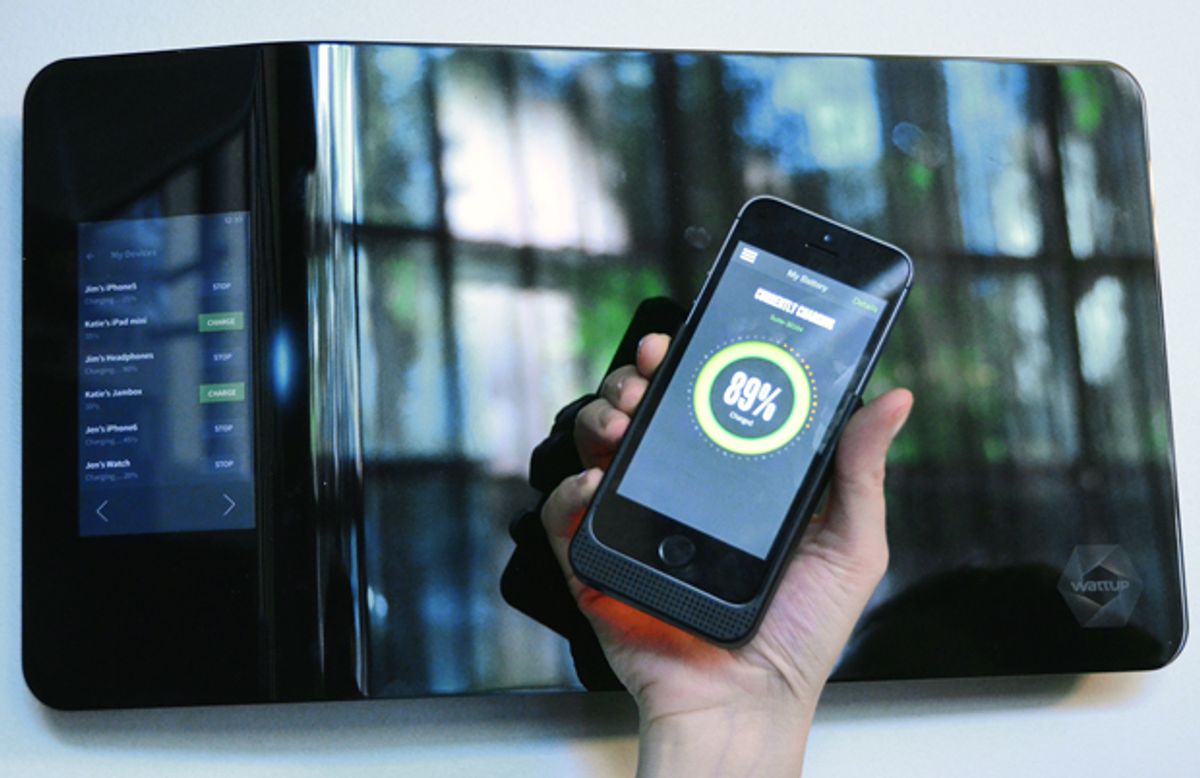In 1891, Nikola Tesla performed an amazing demonstration: He illuminated a gas discharge tube (essentially a fluorescent bulb) with an electric field, showing that it was possible to transmit electric power without wires. Since then, advances in electronics and computing have given us portable versions of his contemporaries’ inventions—Bell’s telephone and Edison’s phonograph. But when it comes to powering up those devices, we’re still tethered in place.
The best we’ve managed to engineer so far is inductive charging: Place your cellphone on top of a resonant inductive charging pad and the pad’s oscillating magnetic field generates a current in the phone’s receiving antenna. The wire may be gone, but the device is still closely bound to the pad until it’s charged, which isn’t quite what Tesla had in mind.
Real progress on wireless power might come as soon as this year. Several companies are promising to deliver the kind of charging that we really want: technology that can charge devices while they’re in our hands, in our pockets, or wherever we happen to put them down. “Promising” is the key word here. Though these systems seem like magic, it’s important to temper any excitement with a healthy dose of the reality imposed by the laws of physics.
Silicon Valley startup Energous Corp. is developing a technology it calls WattUp. At CES 2015 in Las Vegas, IEEE Spectrum saw a private demo of WattUp’s transmitters delivering energy to devices via microwave beams, and we were impressed. Hundreds of small antennas embedded in speakers, televisions, and dedicated router-size boxes directed power to toys, lights, and cellphones over distances of several meters.
WattUp’s sophisticated localization and beam-forming technology allows multiple radio frequency antennas to emit low-power, 5.8-gigahertz beams along different paths that converge in a “pocket” around the targeted device. Together, they generate enough RF power for a metamaterial receiving antenna to harvest. The device—say, a cellphone—is tracked in real time, and the beam paths are continuously updated with its location. The microwaves can bounce off surfaces, so as the device moves, the microwaves can reach the receiving antenna even if it’s not in a WattUp transmitter’s direct line of sight.
Energous recently commissioned a performance evaluation from Underwriters Laboratories. UL verified that, under ideal conditions, a WattUp transmitter is capable of delivering microwaves to up to four devices simultaneously. The amount of power the beams deliver is dependent on distance: 4 watts within 1.5 meters, 2 W within 3 meters, and 1 W within 4.6 meters. Energous wouldn’t comment on the end-to-end efficiency of the system during this test, except to say that its eventual goal is 25 percent efficiency. While it has yet to receive the approval of the U.S. Federal Communications Commission, Energous says it plans to make a splash this month at CES 2016 with an announcement of substantial efficiency improvements and integration into near-market consumer devices.
Energous has a competitor in Ossia, based in Redmond, Wash., which is also developing an RF power delivery system. But engineers at the University of Washington have taken a completely different approach, showing that a reliable source of wireless power is hiding in plain sight. Vamsi Talla, a UW electrical engineering doctoral student, is the lead author of a paper describing Power Over Wi-Fi (PoWiFi), which can distribute tiny but useful amounts of power using an ordinary Wi-Fi router.
Your existing Wi-Fi router, transmitting at full strength, emits enough RF power, at least in theory, to operate or gradually charge very small devices at ranges approaching 10 meters. In practice, this isn’t realistic because your router emits power only when it’s sending data packets. Instead, PoWiFi keeps a stream of “superfluous broadcast traffic” flowing so that the router’s power output is kept at the maximum; this flow of nonessential packets is intelligently managed to avoid interference with the user’s actual Web surfing.
As with WattUp’s microwave beams, the amount of power transferred from PoWiFi’s custom routers to its RF harvesting antennas depends strongly on distance. According to Talla, temperature sensors placed more than 8 meters from a router collected enough charge to return data every few seconds. A modified consumer fitness device left within a few centimeters of a router went from zero to a 41 percent state of charge in 2.5 hours. Six PoWiFi routers, tested in the homes of volunteers, had no discernible impact on the quality of the users’ Internet access.
RF isn’t the only charging modality being promised for 2016. Israeli startup Wi-Charge uses beams of infrared light, and Santa Monica, Calif.–based uBeam relies on ultrasound. uBeam’s recent technical disclosures, and the fact that we’ve yet to see an operational acoustical-to-electrical-energy prototype, have left experts with one big question: How can ultrasound—which needs an unimpeded path and attenuates rapidly in the air—lend itself to power transmission in a world filled with stuff like, say, furniture? [See “Experts Still Think uBeam’s Through-the-Air Charging Tech Is Unlikely,” IEEE Spectrum, November 2015.]
Wireless tech will probably never match the efficiency and effectiveness of a plug in a wall socket. But even if real-world end-to-end efficiency ends up in the single digits—well below Energous’s hoped-for 25 percent—our guess is that it won’t stop many people from wanting to give wireless charging a try.
